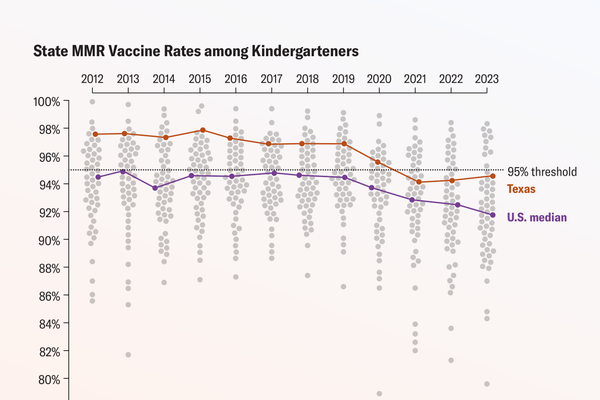www.scientificamerican.com
March 20, 20256 min readCharts Show How Measles Outbreaks Flourish Where Vaccination Rates FallMeasles continues to spread in Texas and other states and has caused the first reported U.S. death from the virus in a decade. Vaccination data over time reveal vulnerabilities in protectionBy Ripley Cleghorn edited by Lauren J. Young Ripley Cleghorn; Source: Centers for Disease Control and Prevention (data)A recent resurgence of measles is hitting multiple U.S. states, sending a concerning number of children to hospitals. In the past two months, public health officials have reported a total of 301 confirmed cases, with more than 170 infections concentrated in Gaines County in West Texas, where a school-aged child died last monthmarking the first measles death in a child in the U.S. in 22 years. And recently an adult in New Mexico died after testing positive for the disease. Both people were unvaccinated. The severityand seemingly continuous spreadof cases in recent outbreaks has experts calling for a closer examination of the nations rates of childhood measles, mumps and rubella (MMR) vaccinations.The MMR vaccines two dose-regimen is 97 percent effective against measles infection. But because the disease is highly contagious, 95 percent of a population needs to be vaccinated to achieve herd immunityprotection that stops disease spread. The state of Texas has an MMR vaccination rate among kindergarteners that is slightly below that threshold, at 94.3 percent, and measles has spread rampantly. Cases have now spanned more than nine Texas counties. How can even a slight decrease in the proportion of vaccinated people lead to such a large outbreak?Measles on a Local LevelOn supporting science journalismIf you're enjoying this article, consider supporting our award-winning journalism by subscribing. By purchasing a subscription you are helping to ensure the future of impactful stories about the discoveries and ideas shaping our world today.One factor is that a slight dip below the recommended vaccination coverage for herd immunity leaves room for outbreaks. Another factor, though, is that state-level data can make it more difficult to trace more local, community-level dynamics that are crucial to understanding how quickly and far outbreaks spread. What really matters for transmission are the people you see every day, says Emily Smith, an epidemiologist and infectious disease researcher at George Washington University.Ripley Cleghorn; Source: Annual Reports of Immunization Status (data)Drilling down further into county-level data can offer more clarity than state-level data, but even that can overshadow whats happening within smaller populations, Smith explains. In Gaines County, most initial cases appear to have occurred within a close-knit, under-vaccinated Mennonite community, according to a state health department spokesperson. Whats more, Gaines County has a large homeschooled population that isnt included in school district dataso the number of unvaccinated children is likely higher than official reports.Texas is one of 45 states that allows for nonmedical exemptionspersonal, religious or bothto childhood immunizations mandated by public and some private schools. In Gaines County, nearly one in five kindergarten students opted out of at least one vaccine last yearfive times the national rate.Why Measles Is a Sentinel for Low Vaccination RatesMeasles is an order of magnitude more contagious than seasonal influenza. Measles virus particles emitted through coughing and sneezing can stay airborne for hours after an infected person leaves an area, making it easy to become infected by a person with whom you havent interacted directly. The reproduction number for measlesthe average number of people who get sick from one infectious personis around 15.Ripley Cleghorn; Source: University of Michigan School of Public Health (data)Most people infected with measles experience a high fever, cough and an unmistakable splotchy red rash. As with polio and hepatitis B, there is no specific treatment for measles. Complications from the disease arent uncommon. One in five unvaccinated people who get infected will end up in the hospital, most commonly because of pneumonia. In Texas, many people who were hospitalizedincluding at least one child younger than six months oldneeded intubation. About one in 1,000 children infected with measles will die, and another one in 1,000 will develop acute brain swelling, or encephalitis, which can occur up to months after infection and can lead to permanent brain damage.A rare type of brain swelling, subacute sclerosing panencephalitis (SSPE), can lead to a chronic measles infection of the brain, says Paul Offit, director of the Vaccine Education Center and an attending physician in the Division of Infectious Diseases at Childrens Hospital of Philadelphia. In people with SSPE, the virus lies dormant for five or even 10 years after complete recovery from the acute illness. Once it resurfaces, people develop a progressive series of neurologic symptomsusually a deterioration of certain personality traits and loss of motor skills, followed by a decline into a vegetative state and invariably death. There is no treatment for this. Children who suffer from this will always die, says Offit, who had measles himself in the 1950s. He has seen five or 10 cases of SSPE in his career.Since the MMR vaccine was introduced in 1971, it has been exhaustively studied and has been shown to be incredibly safe. Side effects, such as fever and soreness from the injection, are mild. It does have a risk of serious effects, but they are much rarer than the risk of measles complicationsand vaccination also lowers the risk of developing severe disease.Zooming out to State and National Trends When national rates for all childhood vaccinations began to fall, pediatricians grew worriedthough the issue was sidelined during the COVID pandemic, when many children got behind on vaccinations because of missed routine appointments. During the 20192020 school year, 95 percent of kindergarteners received all state-mandated vaccines for school attendance. This number dropped to 93 percent in 20222023. For MMR vaccinations, only a few states have bounced back since the peak of the pandemic, and rates have been slowly decreasing, on average, for the past six years.Ripley Cleghorn; Source: Centers for Disease Control and Prevention (data)Ripley Cleghorn; Source: Centers for Disease Control and Prevention (data)Ripley Cleghorn; Source: Centers for Disease Control and Prevention (data)One reason vaccine rates have continued to decline has to do with a distrust in public health, which may worsen under Robert F. Kennedy, Jr.s leadership of the U.S. Department of Health and Human Services, Offit says. Kennedy, a longtime promoter of antivaccine rhetoric, recently wrote an op-ed in Fox News that mentioned the need to make MMR vaccines more accessible after claiming in earlier public comments that the current number of measles outbreaks was not unusual, a statement experts disagree with.This outbreak is atypical in the sense of having sustained local transmission and a child death in west Texas, Smith says. Additionally, outbreaks usually consist of dozens of people, not hundreds, as is happening in Texas. The national case count from the current outbreaks, which began in January, recently surpassed last years total. In previous outbreaks, weve seen an important, hopeful public health response encouraging families to get vaccinated, and were seeing a lot less of that in this particular case, Smith says.Measles was considered eliminated from the U.S. in 2000, following implementation of a recommended second MMR dose for children in 1989. But if low vaccination rates and higher spread of disease continues, experts worry measles could become commonplace again.The MMR vaccine is also just one of more than a dozen vaccines recommended for children. While its still too early to say if declining rates of other childhood vaccines might result in future outbreaks, the current situation with measles paints a foreboding picture. In an interview about cases in 2024 with the podcast Pediatrics Now, JB Cantey, a University of Texas associate professor of pediatrics, warned that measles is the canary in the coal mine for other vaccine-preventable diseases that are going to start to rear their ugly heads in the next few months, next few years, if our vaccine rates continue to drop, Cantey said.The current measles outbreaks demonstrate the importance of herd immunitya vaccinated person is highly affected by the vaccination status of those around them. An example of this played out during a measles outbreak in the Netherlands in 1999 to 2000 with 3,292 reported cases. Unvaccinated individuals were 224 times more likely to get measles than individuals who were vaccinated. Paradoxically, though, a higher number of infections were not among unvaccinated people who lived among vaccinated people but among vaccinated people who lived in clusters of largely unvaccinated individuals.In such a scenario, even if a person is 97 percent protected by the vaccine, [they are] constantly running into people who have measles or am spending a lot of time with them, Smith says. Every time is a chance at the bug breaking down [their] defenses.When populations achieve strong vaccine coverage, cases that appearusually from people traveling in and out of the countrywont spread from one child to another. This prevents the disease from hopping to other communities, Offit explains. He adds that herd immunity also helps protect individuals who are not eligible to receive the MMR vaccine because of their age or health status, including babies and those whose immune systems are suppressed because of treatments for cancers or autoimmune diseases. There are millions of people who... depend on the herd to protect them, Offit says.












